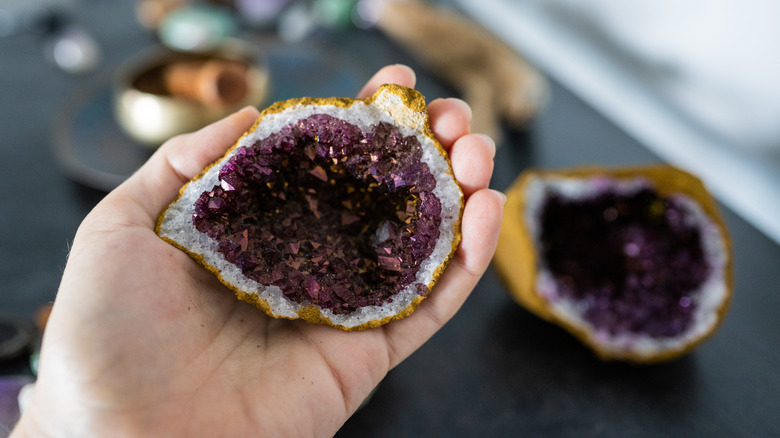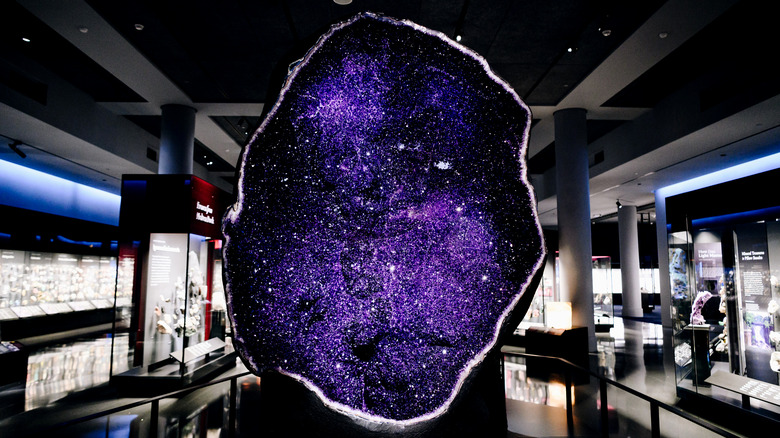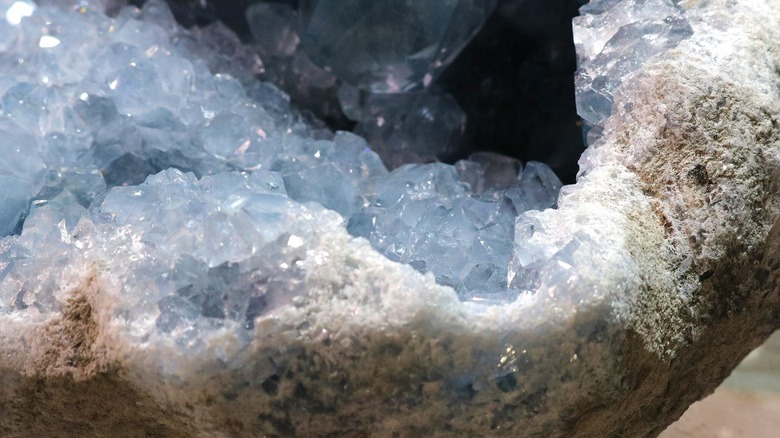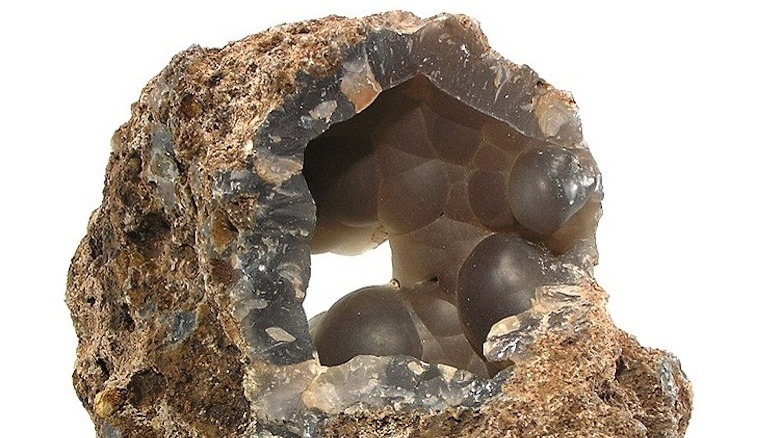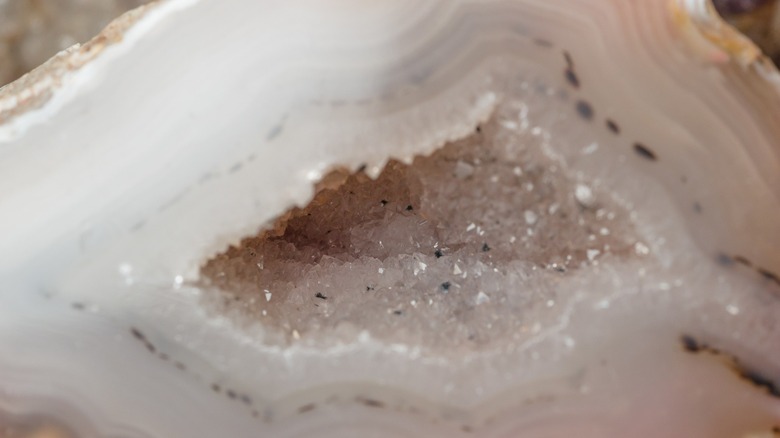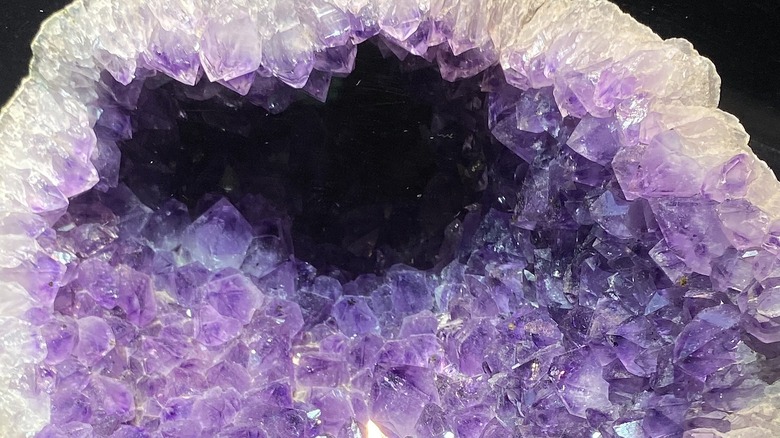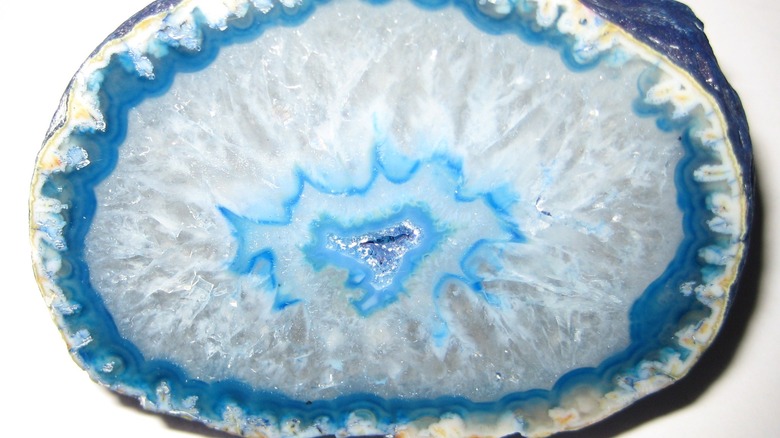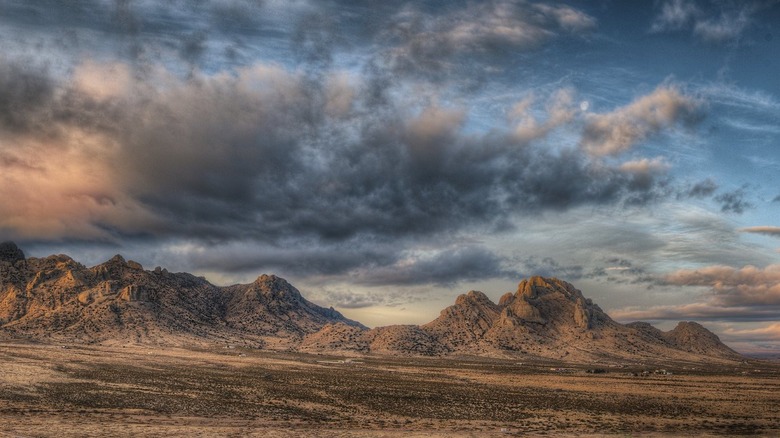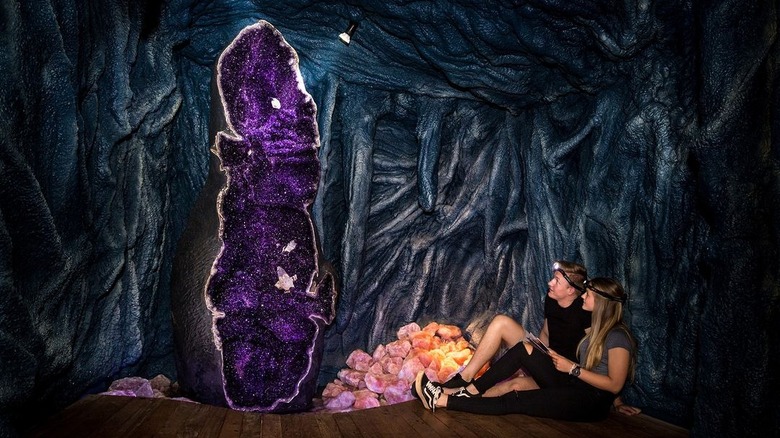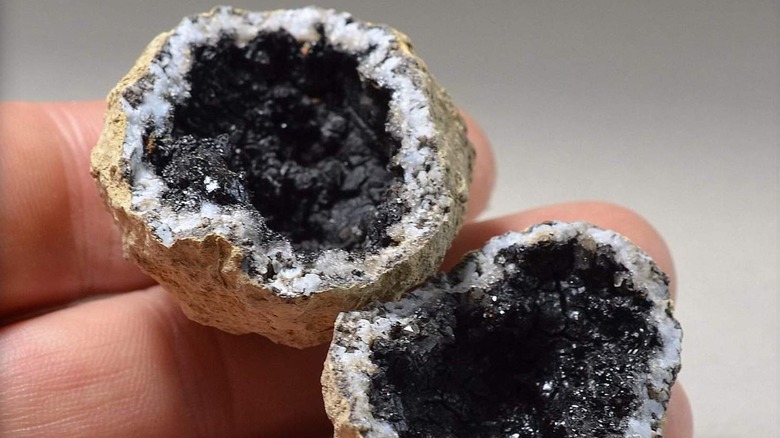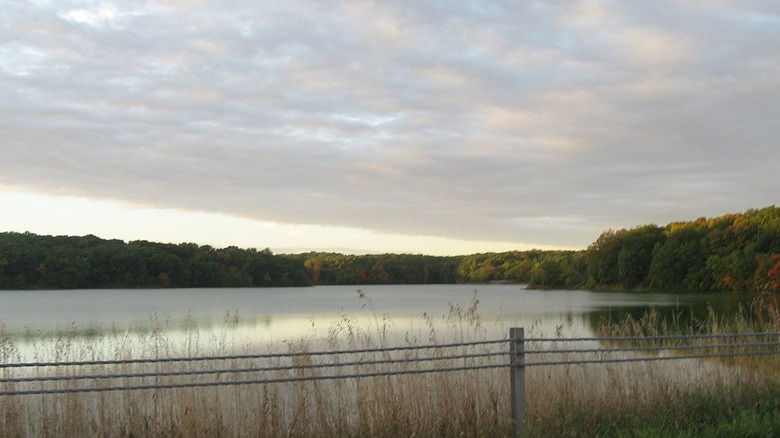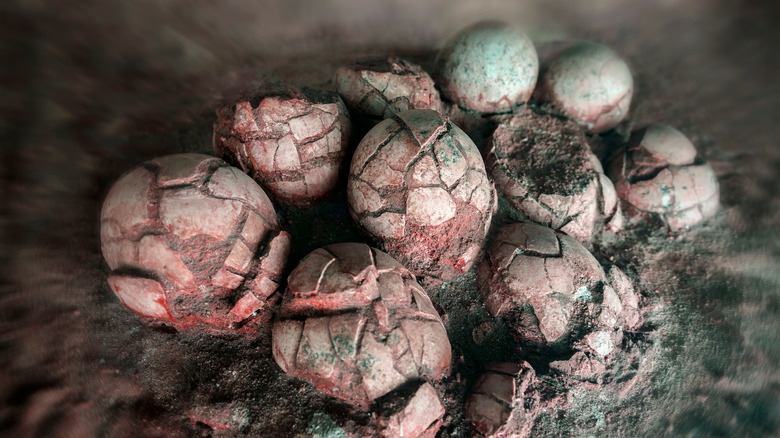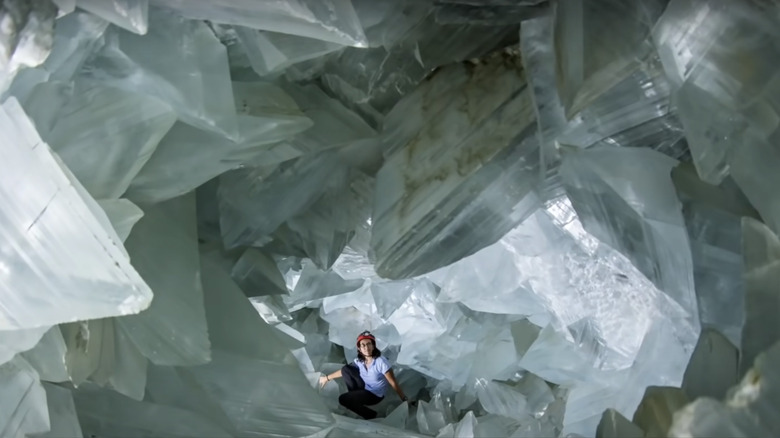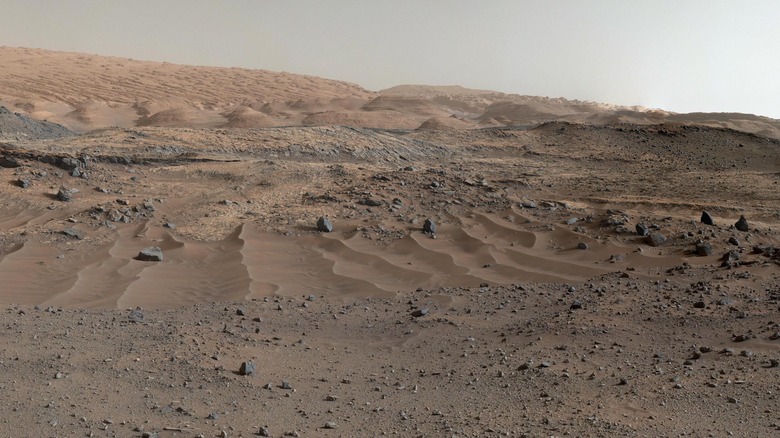13 Fascinating Facts About Geodes
Discovering a geode in the wild feels ever so slightly like some kind of magic. Cracking open a drab-looking stone to find a clutch of sparkling crystals inside seems almost like something that shouldn't really happen. And yet, these hidden treasures of the Earth can be found almost anywhere in the world — provided you know where to look and what to look for.
Geodes, in a nutshell, are hollow stones filled with glistening crystals, and some can be extremely eye-catching. Most often, they form with simple quartz crystals, clear and colorless, but under the right conditions, virtually any kind of crystal can theoretically grow inside a geode. Geodes can be found containing metallic-looking stones like hematite or pyrite. Crystals inside geodes can also have colors, tinted by trace amounts of metal atoms like iron, chromium, or manganese. This can cause geodes to be filled with anything from the vibrant purple of amethyst to the rich pink of rhodochrosite. It's even possible to find geodes lined with shining iridescent opals.
One characteristic trait of all geodes is that they form with a tough outer shell, per Geology.com. It's this sturdy exterior that allows them to survive intact as the rock around them slowly erodes over time. This is what makes them easy to find, sometimes sitting unassumingly alongside stray rubble and pebbles. But there's so much more to these literal hidden gems than meets the eye, and not just in the crystals they contain.
Geodes are always rounded
Geodes always have a rounded appearance from the outside, and this isn't merely by coincidence. It's simply the way they form. The first step to the formation of a geode is a hollow crevice inside otherwise solid rock. Slowly, over time, hard minerals begin to deposit on the inside of this cavity, so the first part of a geode to form is its hard outer shell. As well as being rounded, this is always distinct from the surrounding rock.
This is how to tell the difference from other, similar mineral formations like vugs. A vug can sometimes be mistaken for a geode because the two can look quite similar at first. A vug is any rock cavity lined with crystals, but unlike geodes, these can take on any shape. They aren't necessarily rounded, and they have no hard outer shell. When the surrounding rock is worn away over time, a geode will survive intact but a vug will be worn away too.
Smaller geodes can be roughly spherical or egg-shaped, but they can often have a slightly lumpy appearance, and the exterior of these stones can have a dull appearance, no matter how shiny the crystals hidden inside may be. For their appearance, they're sometimes nicknamed "potato stones," particularly in the U.K.
Geodes are always hollow
One thing that's always true of geodes is that they're hollow. As well as the hard shell and the crystals that line it, a geode will always have an empty space in its center, making them distinct from nodules, another similar type of mineral formation. Nodules are also rounded, and some of them may have originally been geodes, but they're always completely solid. While they sometimes form the same way as geodes, nodules can also form in different ways too. A type called manganese nodules, for instance, forms by slowly building up layers from a smaller core and, per NOAA Ocean Exploration, they can be extremely abundant in some places at the bottom of the ocean.
Geodes are hollow because of the way they form inside rock cavities, and they aren't picky about where they form. Any empty space inside solid rock can become home to a geode, though they're more common in the kind of rocks that naturally contain such voids. Igneous rocks in particular, often contain geodes because they often naturally contain bubbles that formed while the rock was molten. In flows of lava, trapped gasses like carbon dioxide and water vapor puff up these bubbles which are sometimes left behind after the rock cools. Though the rocks themselves were created in an entirely different way, sedimentary rocks like limestone or sandstone can also form geodes.
[Featured image by Art Prof via Flickr | Cropped and scaled | CC BY 2.0]
They have a cryptocrystalline crust
While it may look quite different from the larger crystals on the inside, the shell of a geode is also crystalline, but in a different way. The tough exterior of a geode is usually a specific type of quartz called chalcedony. This stone is microcrystalline, with crystals far too small to see with the naked eye. Chalcedony can sometimes have crystals so small that even a typical microscope can't distinguish them — a type of mineral called cryptocrystalline. Chalcedony shares this trait in common with a few other minerals, notably carbonado diamonds like the Enigma Stone.
Geodes can form in various shapes, and sometimes a geode can grow entirely out of chalcedony. Although this might be a little disappointing for a rock hunter to discover, instead of being filled with large crystals these chalcedony geodes are lined with microscopic crystals instead. While less striking than the usual sparkling crystals, these have a kind of beauty all of their own. As the microscopic crystals grow inwards, they form into rounded hemispherical shapes. The result is a crystal formation called "botryoidal," looking a bit like a pile of grapes.
[Featured image by Rob Lavinsky, iRocks.com via Wikimedia Commons | Cropped and scaled | CC BY-SA 3.0]
They need water to form
An obvious first question about geodes for many people is where exactly the crystals inside geodes come from. The answer, simply, is that geodes cannot form without water, specifically water with dissolved minerals. This water can come from anywhere. It could be regular groundwater or hydrothermal fluid heated by volcanic activity, but the minerals it contains are what the crystals grow from. Moreover, the types of minerals dissolved determine what kind of crystals grow. A little extra iron in the mixture, for example, can give amethyst crystals instead of regular quartz.
Simple quartz is usually the first thing to crystallize though, slowly solidifying on the inside of the rock cavity, forming the hard geode shell. As it builds up gradually, from the outside inward, this can cause the shell of a geode to be full of noticeable bands, slightly like the rings of a tree. As the shell builds up, crystals also begin to grow. This can happen even if the rock doesn't have any obvious opening for water to get in. If the rock is porous, water can slowly seep in, carrying dissolved minerals into the stone with it.
They take thousands of years to crystallize
Geology is full of things that take an exceptionally long time to happen, and growing crystals certainly follow that rule. Most minerals on Earth exist naturally as crystals, and whether inside a geode or on a salt flat, crystals behave in much the same way anywhere, forming an ordered lattice of atoms, arranged layer by layer in a repeating pattern. This pattern determines the shape of the overall crystal, so even when a crystal is large enough to hold in your hand, its appearance is still based on how its individual atoms are arranged. This is the same reason why snowflakes are hexagonal. When they form from dissolved minerals in water, crystals can build up very slowly indeed. With geodes, the whole process of forming an outer crust, building up a shell, and growing crystals on the inside can take thousands of years. The very largest crystals forming this way can even take millions of years. Essentially, the larger the crystals, the older the geode.
[Featured image by Madeleinemcc/Wikimedia Commons | Cropped and scaled | CC BY-SA 3.0]
Some geodes on sale are fake
Natural geodes can be brightly colored, but not always. There are plenty of geodes in the world that contain plain, colorless quartz, but these are less popular with collectors. The result is that some of the geodes on sale are dyed in brighter colors to make them more attractive to potential buyers. Unscrupulous traders may even try to sell these dyed geodes at higher prices. Some varieties, like amethyst geodes, are rarer so they're usually correspondingly more expensive.
There are a few telltale signs that a geode may be adulterated, though. Aside from amethyst, vibrantly colored geodes are quite likely to be dyed, and the colors can also be a giveaway — there are no naturally bright green or deep blue geodes in nature, so if you encounter these colors they're certainly made artificially. Dyed crystals are usually left for weeks, sitting in liquid dye which seeps into their pores and cracks. This means another giveaway that a stone is dyed is that the color will be strongest in all the cracks, crevices, and crystal edges, rather than in the crystals themselves. Of course, some people may prefer these colorful items for decorative purposes, but it's still best not to be under any false impressions about what you're looking at.
[Featured image by Stephanie Clifford via Flickr | Cropped and scaled | CC BY 2.0]
They're most common in deserts
Geodes can form in any rock cavity, but they're most common in volcanic rocks, meaning any ground that contains volcanic stone is a good place to hunt for geodes. When the geology is right though, geodes will form readily, so there are a few places where they're especially common. Mexico, Namibia, and particularly Uruguay are well known for having plentiful numbers of geodes. As well as areas with large amounts of volcanic ash, places rich in limestone are good places to look, but geodes are most often found in the desert. In North America, this means places like California, Nevada, Arizona, and Iowa are particularly good places to find them.
Some desert regions are popular locations for amateur collectors to visit, even becoming named after the practice. One such place is Rockhound State Park, managed by New Mexico's Energy, Minerals, and Natural Resources Department. Full of breathtaking vistas and hiking trails, it's found in the Little Florida Mountains and is named for its long history of being a popular place for geology enthusiasts to go looking for stones. In keeping with the traditions of the area, it's also one of the few state parks in the US where private collectors are permitted to collect stones to take home with them.
[Featured image by John Fowler via Flickr | Cropped and scaled | CC BY 2.0]
The world's largest amethyst geode weighs 2.5 tons
The rarest and most valuable geodes in the world are lined with purple amethyst crystals, and among collectors, Uruguay is famous for its geodes. In particular, the world's largest amethyst geode is named for its country of origin. Known as The Empress of Uruguay, it stands 11 feet tall and weighs a whopping 2.5 tons. It was originally mined in Uruguay's Department of Artigas, home to some of the world's finest amethysts, noted for their particularly intense violet color. This makes Uruguayan geodes have a striking velvety appearance, reminiscent of a starry night sky. Taking full advantage of this, Uruguay exports up to 25,000 tons of gemstones every year, most of them from Artigas.
The Empress of Uruguay is currently on display in the Crystal Caves Museum in Atherton, Australia, where it's been on display since 2007. The museum is home to a staggering collection of minerals from around the world, per the newspaper El Pais, with over 600 stones on display from over 30 countries. The Empress is most certainly the crown jewel in their collection though. The museum's owners paid $75,000 for it, and the stone is so large that they paid another $25,000 to have it transported on the 9,100-mile journey to Queensland. Collectors have offered to buy it from the museum, reportedly offering as much as $300,000, but this incredible rock is no longer for sale.
Some geodes contain crude oil
To form, geodes need water to seep into them, carrying minerals to gradually crystallize, but water isn't the only liquid that can find its way into these hollow stones. Some geodes have been found to contain crude oil. According to the Illinois State Geological Survey, these petroleum geodes are sometimes formed with high enough pressure that the oil gushes out the moment they're broken. They're quite common in the Warsaw Formation, a geologic region in Illinois.
It isn't unheard of for oil to be trapped in minerals as "fluid inclusions," and this can happen with both geodes and vugs. Exactly how petroleum geodes form, though, isn't entirely understood. These oily little stones have been a curiosity for a long time too, being mentioned in an article in a magazine called The Observer from 1893, which noted that they could be found near Fort Madison in Iowa, and very little had been written about them at the time. Reportedly, they sometimes also went by the name of "tar rocks" because as well as oil, they could also be found containing bitumen (as in asphalt).
Geodes are the State Rock of Iowa
The U.S. state of Iowa has wholeheartedly embraced the geode as part of its cultural identity. Per the Iowa Department of Natural Resources, the geode is not only Iowa's official state rock, but it also gave its name to Geode State Park. It's one of the state's finest places for outdoor recreation, both for hiking and boating on Lake Geode. While the park undoubtedly contains plentiful geodes though, it's prohibited for visitors to remove any of the stones themselves.
Among collectors in the US, Iowa has long been especially well known for its geodes. Rock hunters know them by the name of "Keokuk geodes" because one of the most famous places for collecting them is within a 35-mile radius of the city of Keokuk. The local geology also shares this name, with the Keokuk Formation being a large bed of limestone in the area, where geodes form. Enthusiasts report that they're particularly easy to find in certain stream beds, where water erodes the surrounding rock and leaves geodes to pile up in drainage channels. With Iowa being so well known for them, geodes were named the official state rock in 1967 to promote tourism and attract geology enthusiasts.
Geodes have formed from dinosaur eggs
Fossil hunting and geode hunting have a lot in common. To the trained eye, in the right location, fossil-containing rocks are quite easy to spot even before they're split open. Trapped in sedimentary rock, fossils can sometimes cause geodes to form too. Occasionally, the original fossil may weather away over time, leaving behind a cavity in which a geode can begin to crystallize. Very rarely though, something more exceptional can happen; under the right conditions, fossils themselves can become geodized, with shining crystals forming inside them.
In 2022, the South China Morning Post reported on a set of geodes found in Anhui Province, Eastern China, which formed inside fossilized dinosaur eggs. One of them was broken open, revealing a set of white quartz crystals inside. Most remarkably of all, the eggs themselves were laid by a previously unknown species of dinosaur, now dubbed Shixingoolithus qianshanensis. The geode eggs are just a few of the numerous fossil dinosaur eggs that have been unearthed by paleontologists all across China, but they're certainly the most dramatic.
This wasn't the first time geodized fossil eggs have been discovered either. Previously, a set of fossil crocodile eggs at the Smithsonian Museum were found to have crystallized into geodes. Elsewhere, a titanosaur egg unearthed in Mongolia in 2011 was also discovered to be a geode, filled with calcite crystals.
The largest geodes are entire caves
In the depths of an old silver mine in Pulpí, Spain, lies what may be the world's largest geode, nicknamed Geoda Gigante. Per BBC Travel, it's around 26 feet wide and around 6.5 feet high, making it large enough to stand inside. The stunning crystal cave was originally discovered by miners, who were probably disappointed by their find — crystals like these are heavy to move and not especially profitable compared to the silver they were mining for. The crystals themselves are likely under 2 million years old and may date back to a time when the whole area was underwater. Some geologists think the formation of this huge geode may be linked to an ancient event known dramatically as the Messinian Salinity Crisis when the Mediterranean Sea nearly dried out.
There are a few other crystal caves in the world, but not all are true geodes. Some of the largest crystals in the world can be found in the Cave of Crystals, found in Naica, Mexico. While these are truly colossal, this cave is not really a geode, with the crystals growing directly on the cave walls. Technically, this makes it a vug. Similarly, another previous contender for the world's largest geode is Ohio's Crystal Cave beneath Heineman's Winery. Often called the world's largest geode, this too is actually a vug — but this certainly shouldn't detract from the grandeur of the cave with its celestine crystals reaching up to 3 feet in length.
There are probably geodes on Mars
The word geode can be traced back to an Ancient Greek word, geodes (γεώδης), meaning "earthy" or "earth-like." So it may be surprising to learn that these fascinating stones are probably not only found on Earth. Geodes need water to form, and it's almost certain that Mars used to have abundant water long ago. In fact, there's growing evidence to suggest that Mars has lost entire oceans of water in the distant past.
As Forbes notes, with geodes forming so readily here on Earth, there's every reason to believe they may have formed on Mars too. Any geodes there would likely date back to a time when Earth's sister planet was much more active, with not only water but volcanic activity. With Earth's largest geodes being tied to seas drying up, there's even a chance Mars could also have formed some sizeable geodes as the entire planet began to dry out 3 billion years ago.
So far, Martian geology (more properly called areology) is still a young field of scientific study, and all the discoveries in Mars exploration have been made by robots. A few interesting things have been spotted on the surface of Mars though, like an unusual rock found in 2014, nicknamed the "jelly doughnut" for its appearance. Once human geologists can investigate the planet directly, perhaps it'll be only a matter of time before Martian geodes are discovered. Though, being far from Earth, maybe we should consider calling those areodes.
